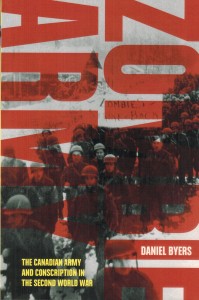Canada’s last military conscription was popular. Resisters were scorned as weaklings who failed the tests of manhood and citizenship. Perceptions of the draft today are coloured by unpopular American wars – even deserters are treated as heroes – but facts are facts. Our conscription experience is a uniquely Canadian story, and Professor Daniel Byers of Laurentian University tells it well.
“The impacts of conscription and the National Resources Mobilization Act were largely forgotten in almost every way after the Second World War,” writes Byers. “For almost five full years the country had been mobilized to an extent that Canadians had not experienced before, nor have they since. Dozens of training centres and military camps stretched across the country. More than a million men and women served in the armed forces, over 150,000 of them as conscripts.”
Canadians voted for conscription in a 1942 plebiscite; 64 percent supported it outside Québec while opposition ran to 85 percent of Québec francophones. The conflict was more nuanced than the votes imply.
Volunteers from the Gaspé suffered alongside Winnipeg Grenadiers in the first combat action of Canada’s war, at the disastrous 1941 Battle of Hong Kong. Professor Byers notes some French districts in Québec actually topped their enlistment quotas, while a few English districts in Ontario and British Columbia did not. Well into the 1950s, Québec populists like Social Credit MP Réal Caouette articulated the anti-conscription argument in terms any family could grasp: “You think your children belong to you, but not in wartime,” he said. “In war your children belong to the government.”
Yet the contempt was real. Conscripts were scorned, and the Prime Minister who waited till 1944 to send them overseas was personally unpopular. The soldier vote cost Mackenzie King his Commons seat in a 1945 election. “His refusal to take a stand frustrated not only some of his fellow Canadians but also British leaders who were looking for some sign of the Dominion’s intentions,” write Prof. Byers.
Zombie Army recounts this whole vivid clash through a crisp narrative and meticulous research. “Zombies” was among the more polite terms for conscripts. Prof. Byers quotes one commander of B.C.’s 13th Infantry Brigade who recalled the “taunts and jibes” against draftees: “westypoofs,” “women’s home companions,” “pantywaists,” “poltroons,” “lily livered” and “other unmentionables.”
Who were the Zombies? Byers examines newly-released archival records in compiling a statistical profile of the typical conscript: under 25, single, a farmer or factory worker, Roman Catholic – boys, really. Four thousand of them ran away rather than fight overseas, and remained unaccounted for when cabinet declared a deserters’ amnesty in 1946.
Zombie Army tells the whole arresting story with an even hand and smart commentary. It is as compelling as the subject.
By Holly Doan
Zombie Army: The Canadian Army and Conscription in the Second World War, by Daniel Byers; University of British Columbia Press; 344 pages; ISBN 9780-7748-30522; $34.95








